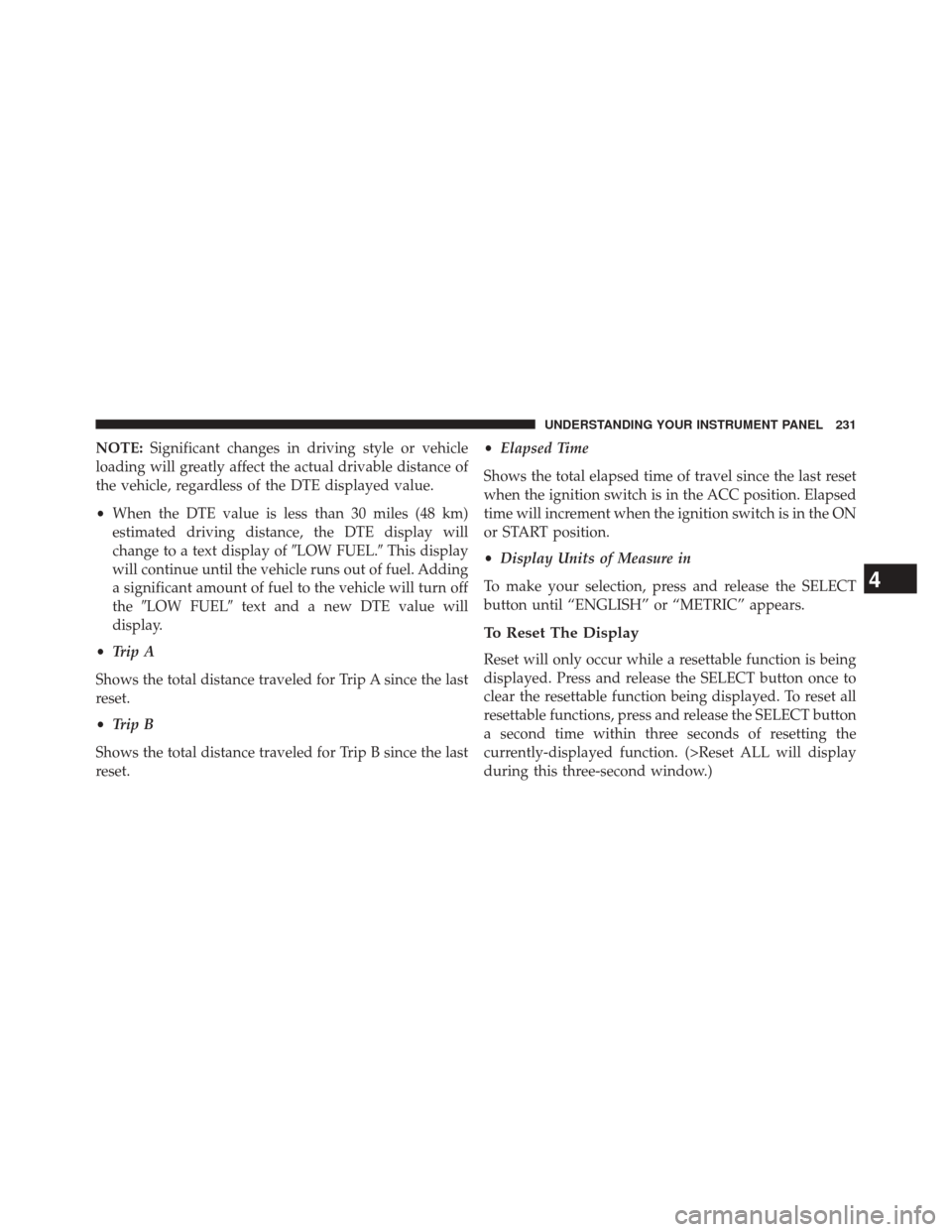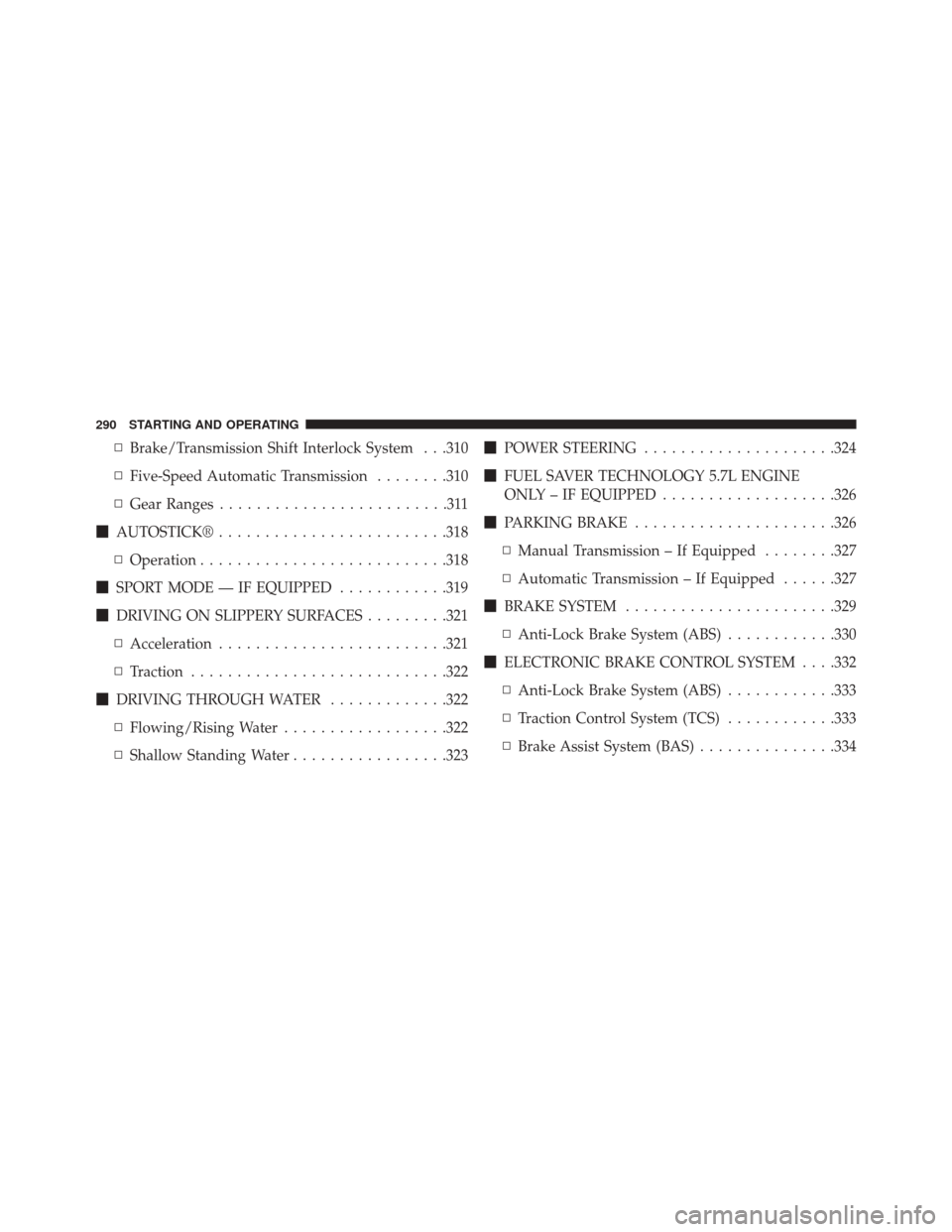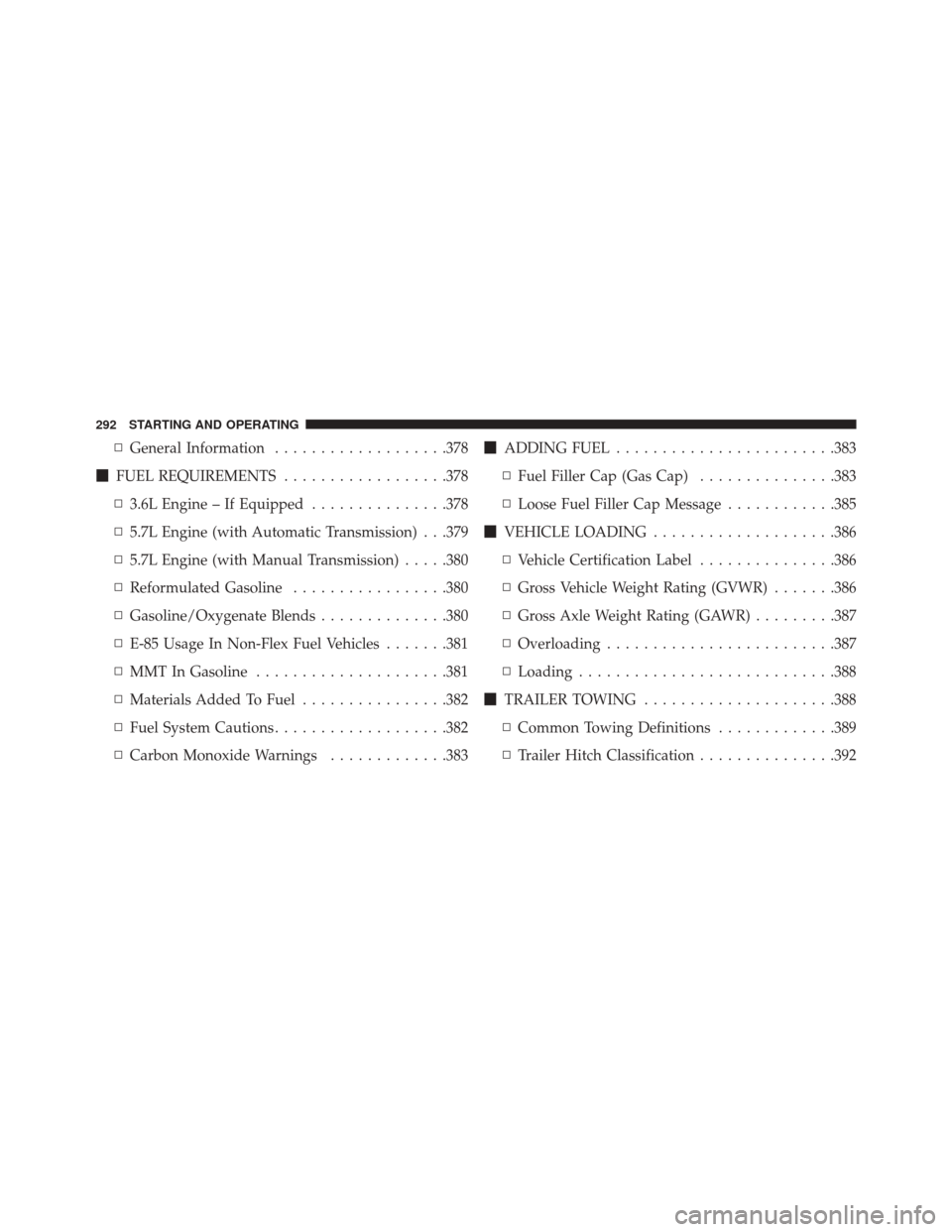Page 232 of 543
•This feature allows you to monitor when you are
driving in a fuel efficient manner, and it can be used to
modify driving habits in order to increase fuel
economy. •
Distance To Empty (DTE)
• Shows
the estimated distance that can be traveled with
the fuel remaining in the tank. This estimated distance is
determined by a weighted average of the instantaneous
and average fuel economy, according to the current fuel
tank level. DTE cannot be reset through the SELECT
button.
Fuel Saver Mode–OnFuel Saver Mode–Off
230 UNDERSTANDING YOUR INSTRUMENT PANEL
Page 233 of 543

NOTE:Significant changes in driving style or vehicle
loading will greatly affect the actual drivable distance of
the vehicle, regardless of the DTE displayed value.
• When the DTE value is less than 30 miles (48 km)
estimated driving distance, the DTE display will
change to a text display of �LOW FUEL.�This display
will continue until the vehicle runs out of fuel. Adding
a significant amount of fuel to the vehicle will turn off
the �LOW FUEL� text and a new DTE value will
display.
• Trip A
Shows the total distance traveled for Trip A since the last
reset.
• Trip B
Shows the total distance traveled for Trip B since the last
reset. •
Elapsed Time
Shows the total elapsed time of travel since the last reset
when the ignition switch is in the ACC position. Elapsed
time will increment when the ignition switch is in the ON
or START position.
• Display Units of Measure in
To make your selection, press and release the SELECT
button until “ENGLISH” or “METRIC” appears.
To Reset The Display
Reset will only occur while a resettable function is being
displayed. Press and release the SELECT button once to
clear the resettable function being displayed. To reset all
resettable functions, press and release the SELECT button
a second time within three seconds of resetting the
currently-displayed function. (>Reset ALL will display
during this three-second window.)
4
UNDERSTANDING YOUR INSTRUMENT PANEL 231
Page 292 of 543

▫Brake/Transmission Shift Interlock System . . .310
▫ Five-Speed Automatic Transmission ........310
▫ Gear Ranges .........................311
� AUTOSTICK® ........................ .318
▫ Operation .......................... .318
� SPORT MODE — IF EQUIPPED ............319
� DRIVING ON SLIPPERY SURFACES .........321
▫ Acceleration ........................ .321
▫ Traction ........................... .322
� DRIVING THROUGH WATER .............322
▫ Flowing/Rising Water ..................322
▫ Shallow Standing Water .................323 �
POWER STEERING .....................324
� FUEL SAVER TECHNOLOGY 5.7L ENGINE
ONLY – IF EQUIPPED ...................326
� PARKING BRAKE ..................... .326
▫ Manual Transmission – If Equipped ........327
▫ Automatic Transmission – If Equipped ......327
� BRAKE SYSTEM ...................... .329
▫ Anti-Lock Brake System (ABS) ............330
� ELECTRONIC BRAKE CONTROL SYSTEM . . . .332
▫ Anti-Lock Brake System (ABS) ............333
▫ Traction Control System (TCS) ............333
▫ Brake Assist System (BAS) ...............334
290 STARTING AND OPERATING
Page 294 of 543

▫General Information ...................378
� FUEL REQUIREMENTS ..................378
▫ 3.6L Engine – If Equipped ...............378
▫ 5.7L Engine (with Automatic Transmission) . . .379
▫ 5.7L Engine (with Manual Transmission) .....380
▫ Reformulated Gasoline .................380
▫ Gasoline/Oxygenate Blends ..............380
▫ E-85 Usage In Non-Flex Fuel Vehicles .......381
▫ MMT In Gasoline .....................381
▫ Materials Added To Fuel ................382
▫ Fuel System Cautions ...................382
▫ Carbon Monoxide Warnings .............383�
ADDING FUEL ....................... .383
▫ Fuel Filler Cap (Gas Cap) ...............383
▫ Loose Fuel Filler Cap Message ............385
� VEHICLE LOADING ....................386
▫ Vehicle Certification Label ...............386
▫ Gross Vehicle Weight Rating (GVWR) .......386
▫ Gross Axle Weight Rating (GAWR) .........387
▫ Overloading ........................ .387
▫ Loading ........................... .388
� TRAILER TOWING .....................388
▫ Common Towing Definitions .............389
▫ Trailer Hitch Classification ...............392
292 STARTING AND OPERATING
Page 297 of 543

Press the clutch pedal fully to the floor, and turn the
ignition switch to the START position and release when
the engine starts. If the engine fails to start within
15 seconds, turn the ignition switch to the OFF position,
wait 10 to 15 seconds, then repeat the “Normal Starting”
procedure.
WARNING!
Do not attempt to push or tow your vehicle to get it
started. Unburned fuel could enter the catalytic con-
verter and once the engine has started, ignite and
damage the converter and vehicle. If the vehicle has
a discharged battery, booster cables may be used to
obtain a start from another vehicle. This type of start
can be dangerous if done improperly, so follow the
procedure carefully. Refer to “Jump Starting” in
“What To Do In Emergencies” for further informa-
tion.
Automatic Transmission – If Equipped
The shift lever must be in the NEUTRAL or PARK
position before you can start the engine. Apply the brakes
before shifting into any driving gear.
CAUTION!
Damage to the transmission may occur if the follow-
ing precautions are not observed:
•Do not shift from REVERSE, PARK, or NEUTRAL
into any forward gear when the engine is above
idle speed.
• Shift into PARK only after the vehicle has come to
a complete stop.
• Shift into or out of REVERSE only after the vehicle
has come to a complete stop and the engine is at
idle speed.
• Before shifting into any gear, make sure your foot
is firmly on the brake pedal.
5
STARTING AND OPERATING 295
Page 303 of 543

If Engine Fails To Start
WARNING!
•Never pour fuel or other flammable liquids into
the throttle body air inlet opening in an attempt to
start the vehicle. This could result in a flash fire
causing serious personal injury.
• Do not attempt to push or tow your vehicle to get it
started. Vehicles equipped with an automatic trans-
mission cannot be started this way. Unburned fuel
could enter the catalytic converter and once the
engine has started, ignite and damage the converter
and vehicle.
(Continued)
WARNING! (Continued)
•If the vehicle has a discharged battery, booster
cables may be used to obtain a start from a booster
battery or the battery in another vehicle. This type
of start can be dangerous if done improperly. Refer
to “Jump Starting” in “What To Do In Emergen-
cies” for further information.
Clearing A Flooded Engine (Using ENGINE
START/STOP Button) – Automatic Transmission
Only
If the engine fails to start after you have followed the
“Normal Starting” or “Extreme Cold Weather� proce-
dures, it may be flooded. To clear any excess fuel, press
and hold the brake pedal, push the accelerator pedal all
the way to the floor and hold it, then press and release the
ENGINE START/STOP button once. The starter motor
will engage automatically, run for 10 seconds, and then
5
STARTING AND OPERATING 301
Page 304 of 543

disengage. Once this occurs, release the accelerator pedal
and the brake pedal, wait 10 to 15 seconds, then repeat
the “Normal Starting” procedure.
Clearing A Flooded Engine (Using ENGINE
START/STOP Button) – Manual Transmission Only
If the engine fails to start after you have followed the
“Normal Starting” or “Extreme Cold Weather�proce-
dures, it may be flooded. To clear any excess fuel, press
and hold the clutch pedal, push the accelerator pedal all
the way to the floor and hold it, then press and hold the
ENGINE START/STOP button for no more than 15 sec-
onds. Release the accelerator pedal and the clutch pedal,
wait 10 to 15 seconds, then repeat the “Normal Starting”
procedure.
Clearing A Flooded Engine (Using Fob With
Integrated Key)
If the engine fails to start after you have followed the
“Normal Starting” or “Extreme Cold Weather” proce-
dures, it may be flooded. To clear any excess fuel:
1. Press the accelerator pedal all the way to the floor and hold it.
2. Turn the ignition switch to the START position and release it as soon as the starter engages.
The starter motor will disengage automatically in 10 sec-
onds. Once this occurs, release the accelerator pedal, turn
the ignition switch to the LOCK position, wait 10 to
15 seconds, then repeat the “Normal Starting” procedure.
302 STARTING AND OPERATING
Page 308 of 543

The spring will try to pull the shift lever toward third and
fourth gear. Make sure you move the shift lever into
second or fifth gear. If you let the shift lever move in the
direction of the pulling, you may end shifting from first
to fourth or from sixth to third gear.
CAUTION!
Always make sure the vehicle comes to a complete
stop before shifting into REVERSE. Failure to do so
may result in transmission damage.
You must always use first gear (or Reverse) when starting
from a standing position.
Recommended Shift Speeds
To utilize your manual transmission efficiently for fuel
economy, it should be upshifted as listed in recom-
mended shift speed chart.
MANUAL TRANSMISSION RECOMMENDED SHIFT SPEEDS
Axle
Ratio 1-4 4-5 5-6
3.73 mph 20 25 42 (km/h) (32) (40) (67)
3.91 mph 20 37 48 (km/h) (32) (59) (77)
Earlier upshifts during cruise conditions (relatively
steady speeds) may result in increased fuel economy.
Higher upshift speeds may be used to obtain a desired
acceleration rate.
306 STARTING AND OPERATING